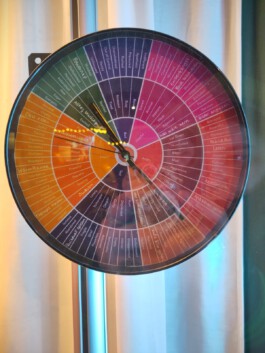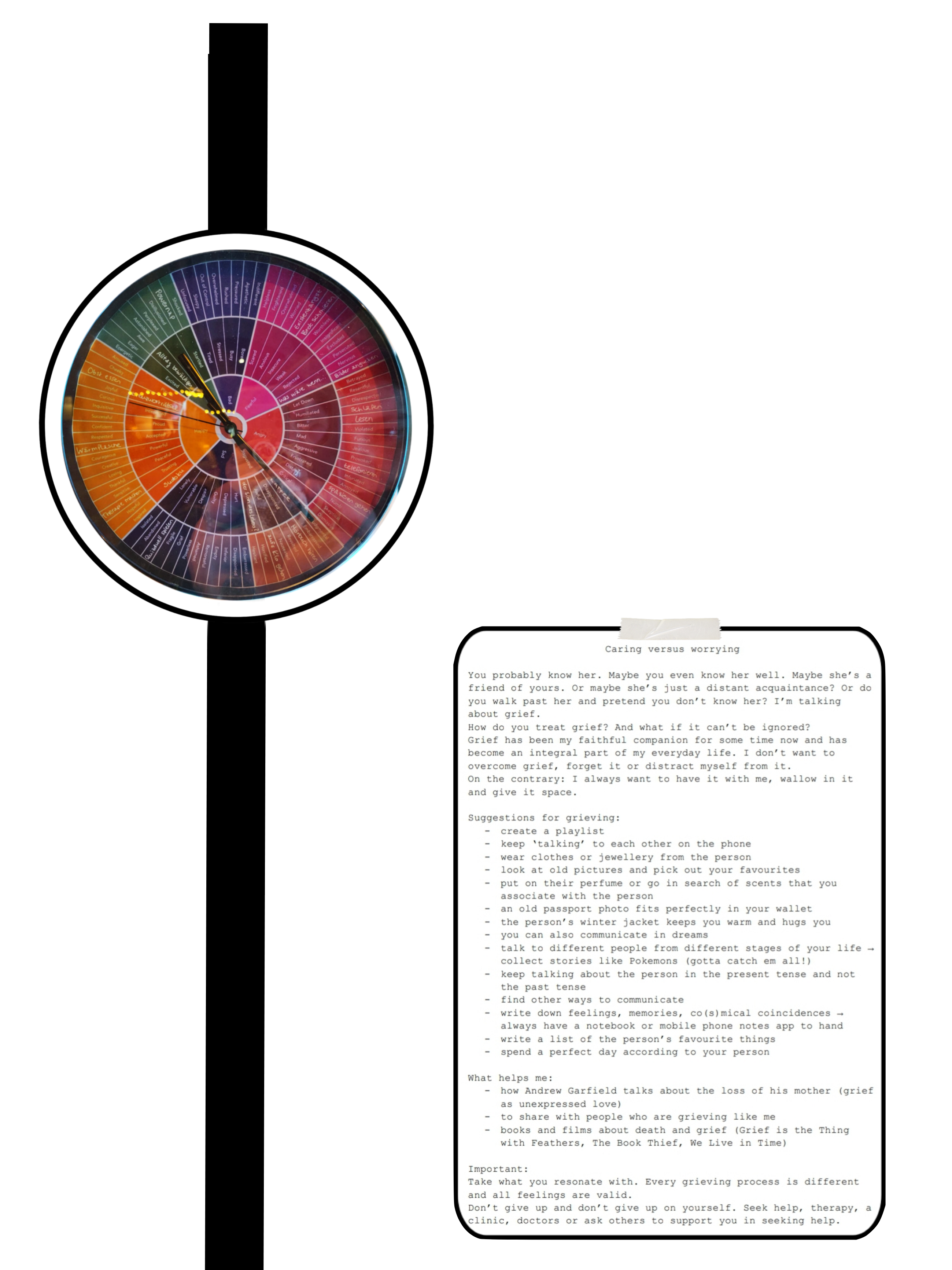KISSING MY KUMPELS* GOODNIGHT
Leonie Schröter
Zeit zum Trauern
Uhr, Poster, Handout / clock, poster, handout / zegar, plakat, materiały informacyjne

Fotos: Cosmo Glanc
(DE) Trauer betrifft uns alle und ist allgegenwärtig. Wir trauern um Verstorbene, Verschollene, Verschwundene, um Menschen, Tiere, die Natur und Landschaften, um „verlorene“ oder „verschwendete“ Zeit. Doch was ist Trauer eigentlich und wie trauere ich richtig? Ich sehne mich nach einer Anleitung. Trauer und die damit verbundenen Gefühle können verwirren und sich widersprechen und manchmal einfach viel zu viel sein. Alle Gefühle sind valide. Es ist vollkommen okay, weinend und wütend, ein Brot zu schmieren.
Meine Gefühls-Uhr basiert auf dem „Feelings Wheel“
(EN) Time to Mourn
Grief affects us all and is omnipresent. We grieve for the deceased, the missing, the disappeared, for people, animals, nature and landscapes, for “lost” or “wasted” time. But what is grief actually and how do I grieve properly? I long for some guidance. Grief and the feelings associated with it can be confusing and contradictory and sometimes simply too much. All feelings are valid. It’s perfectly okay to cry and be angry and butter a sandwich.
My feelings clock is based on the “Feelings Wheel”
(PL) Czas na żałobę
Żal dotyka nas wszystkich i jest wszechobecny. Opłakujemy zmarłych, zaginionych, ludzi, zwierzęta, przyrodę i krajobrazy, „stracony” lub „zmarnowany” czas. Ale czym właściwie jest żałoba i jak ją właściwie przeżywać? Tęsknię za wskazówkami. Żałoba i związane z nią uczucia, mogą być mylące i sprzeczne, a czasami po prostu zbyt duże. Wszystkie uczucia są ważne. Jest w porządku, gdy płaczę, złoszczę się i równocześnie smaruję kanapkę.
Mój zegar uczuć opiera się na „Kole uczuć”

(DE) Fürsorgen gegen Sorgen
Du kennst sie bestimmt. Vielleicht kennst du sie sogar gut. Vielleicht ist sie eine Freundin von dir. Vielleicht aber auch nur eine entfernte Bekannte? Oder gehst du an ihr vorbei und tust so, als würdest du sie nicht kennen? Ich rede von Trauer.
Wie behandelst du sie? Und was, wenn sie sich nicht ignorieren lässt?
Trauer ist seit einiger Zeit meine treue Begleiterin und fester Bestandteil meines Alltags geworden. Ich möchte Trauer nicht überwinden, sie vergessen oder mich ablenken.
Im Gegenteil: Ich will sie immer bei mir haben, mich in ihr suhlen und ihr Raum geben.
Anregungen zum Trauern:
-erstelle eine Playlist
-„telefoniert” weiterhin miteinander
-trag Klamotten oder Schmuck von der Person
-guck dir alte Bilder an und such dir deine Favoriten raus
-trag das Parfum von ihr oder begib dich auf die Suche nach Gerüchen, die du mit der Person verbindest
-ein altes Passbild passt perfekt ins Portmonee
-die Winterjacke der Person hält dich warm und umarmt dich
-auch in Träumen lässt sich kommunizieren
-rede mit verschiedenen Menschen aus verschiedenen Lebensabschnitten → sammle Geschichten wie Pokemons (gotta catch em all!)
-rede weiterhin im Präsens und nicht im Präteritum von der Person
-finde andere Wege zum Kommunizieren
-schreibe Gefühle, Erinnerungen, ko(s)mische Zufälle auf → hab immer ein Notizbuch oder die Handy-Notizen-App griffbereit
-schreibe eine Liste mit den Lieblingsdingen der Person
-verbringe einen Tag ganz nach dem Geschmack der Person
Mir hilft:
-wie Andrew Garfield über den Verlust seiner Mutter redet (grief as unexpressed love)
-mich mit Menschen auszutauschen, die ähnlich trauern wie ich
-Bücher und Filme über das Thema Tod und Trauer (Trauer ist das Ding mit Federn, Die Bücherdiebin, We Live in Time)
Wichtig:
Nimm dir, womit du resonierst. Jeder Trauerprozess ist anders und alle Gefühle sind valide.
Gib nicht auf und gib dich nicht auf. Suche dir Hilfe, Therapie, Klinik, Ärzt*innen oder bitte Andere dich beim Hilfesuchen zu unterstützen.
(EN) Caring versus worrying
You probably know her. Maybe you even know her well. Maybe she’s a friend of yours. Or maybe she’s just a distant acquaintance? Or do you walk past her and pretend you don’t know her? I’m talking about grief.
How do you treat grief? And what if it can’t be ignored?
Grief has been my faithful companion for some time now and has become an integral part of my everyday life. I don’t want to overcome grief, forget it or distract myself from it.
On the contrary: I always want to have it with me, wallow in it and give it space.
Suggestions for grieving:
-create a playlist
-keep ‘talking’ to each other on the phone
-wear clothes or jewellery from the person
-look at old pictures and pick out your favourites
-put on their perfume or go in search of scents that you associate with the person
-an old passport photo fits perfectly in your wallet
-the person’s winter jacket keeps you warm and hugs you
-you can also communicate in dreams
-talk to different people from different stages of your life → collect stories like Pokemons (gotta catch em all!)
-keep talking about the person in the present tense and not the past tense
-find other ways to communicate
-write down feelings, memories, co(s)mical coincidences → always have a notebook or mobile phone notes app to hand
-write a list of the person’s favourite things
-spend a perfect day according to your person
What helps me:
-how Andrew Garfield talks about the loss of his mother (grief as unexpressed love)
-to share with people who are grieving like me
-books and films about death and grief (Grief is the Thing with Feathers, The Book Thief, We Live in Time)
Important:
Take what you resonate with. Every grieving process is different and all feelings are valid.
Don’t give up and don’t give up on yourself. Seek help, therapy, a clinic, doctors or ask others to support you in seeking help.
(PL) Troska, kontra zmartwienie
Prawdopodobnie znasz tę osobę. Może nawet dobrze ją znasz. Może jest twoim przyjacielem*. A może to tylko daleki znajomy? A może przechodzisz obok niego i udajesz, że go nie znasz? Mówię oczywiście o żalu.
Jak go traktować? A co jeśli nie można go zignorować?
Żal jest moim wiernym towarzyszem już od jakiegoś czasu i stał się integralną częścią mojego codziennego życia. Nie chcę przezwyciężyć smutku, zapomnieć o nim lub odwrócić od niego uwagę.
Wręcz przeciwnie: zawsze chcę go mieć przy sobie, pogrążać się w nim i dawać mu przestrzeń.
Sugestie dotyczące żałoby:
-stwórz playlistę
-„Rozmawiajcie” ze sobą przez telefon
-noś ubrania lub biżuterię od niej/niego*
-oglądaj stare zdjęcia i wybieraj ulubione
-użyj jej perfum lub poszukaj zapachów, które kojarzą ci się z tą osobą
-stare zdjęcie paszportowe idealnie pasuje do portfela
-zimowa kurtka tej osoby zapewnia ciepło i uczucie przytulenia
-przez sen również można się kontaktować
-rozmawiaj z ludźmi z różnych etapów swojego życia →zbieraj historie jak Pokemony (musisz złapać je wszystkie!)
-mów o danej osobie w czasie teraźniejszym, a nie przeszłym
-znajdź inne sposoby komunikacji
-zapisuj uczucia, wspomnienia, zabawnych/ko(s)micznych zbiegów okoliczności → Zawsze miej pod ręką notatnik, lub aplikację do notatek na telefonie komórkowym.
-napisz listę ulubionych rzeczy danej osoby
-spędź idealny dzień według danej osoby
pomaga mi:
-jak Andrew Garfield mówi o stracie matki (żałoba jako niewyrażona miłość)
-dzielenie się z ludźmi, którzy przeżywają żałobę tak jak ja
-książki i filmy o śmierci i żałobie (Grief is the thing with feathers, The Book Thief, We live in Time).
Ważne:
Weź to, co cię wzrusza. Każdy proces żałoby jest inny i wszystkie uczucia są ważne.
Nie poddawaj się i nie rezygnuj z siebie. Poszukaj pomocy, terapii, kliniki, lekarzy lub poproś innych o wsparcie w poszukiwaniu pomocy.